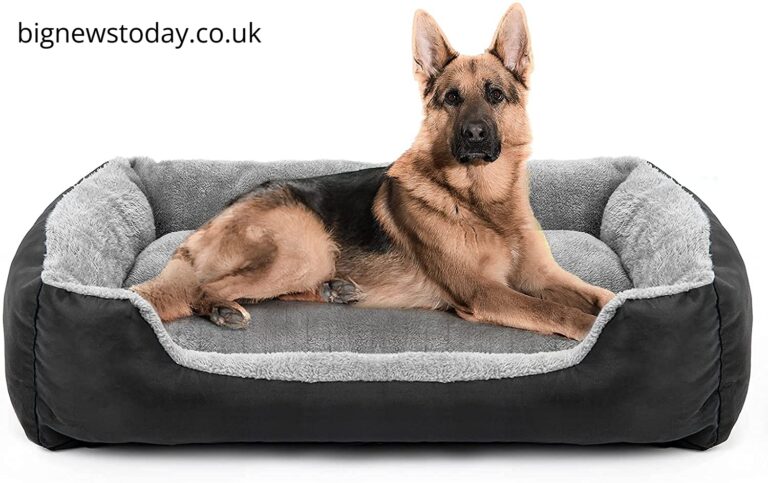Finding the right dog bed is essential for your furry friend’s comfort and health. A well-chosen dog bed not only provides a cozy spot for rest but also supports your pet’s overall well-being. With so many options available, selecting the perfect bed can seem overwhelming. In this guide, we’ll break down everything you need to know about dog beds, from types and sizes to materials and maintenance, ensuring that you make an informed choice for your beloved companion.
1. Why a Good Dog Bed Matters
Comfort and Support:
A high-quality dog bed offers more than just a place to sleep. It provides crucial support for your pet’s joints and muscles, which is especially important for older dogs or those with specific health conditions. A well-cushioned bed helps reduce pressure on your dog’s body, promoting better sleep and overall comfort.
Safe Space:
A dedicated dog bed serves as a safe and personal space for your pet. It offers a sense of security and belonging, helping your dog feel at ease in their environment. This is particularly beneficial for dogs that experience anxiety or stress.
Health Benefits:
Choosing the right bed can contribute to your dog’s health by providing proper support and reducing the risk of issues such as arthritis or hip dysplasia. A clean, well-maintained bed also minimizes the risk of skin infections and allergies.
2. Types of Dog Beds
**1. Orthopaedic Dog Beds:
Orthopaedic dog beds are designed to provide extra support and comfort, particularly for older dogs or those with joint issues. They often feature memory foam or gel-infused padding to relieve pressure points and promote better sleep.
**2. Bolster Dog Beds:
Bolster dog beds come with raised edges that provide a sense of security and support for your pet’s head and neck. These beds are ideal for dogs that like to curl up or rest their heads on something while they sleep.
**3. Donut Dog Beds:
Donut dog beds are round with a cushioned, raised edge, offering a snug and cozy space for dogs that enjoy curling up. They provide warmth and comfort, making them a popular choice for smaller breeds or dogs that love to snuggle.
**4. Cooling Dog Beds:
Cooling dog beds are designed to help regulate your pet’s body temperature, making them perfect for hot climates or dogs that overheat easily. These beds often feature cooling gel or breathable materials to keep your dog comfortable.
**5. Elevated Dog Beds:
Elevated dog beds are raised off the ground, providing better airflow and keeping your pet cool and dry. They are easy to clean and ideal for outdoor use or areas with high humidity.
3. Choosing the Right Size and Material
Size Considerations:
When selecting a dog bed, size is a crucial factor. Ensure the bed is large enough for your dog to stretch out comfortably. Measure your dog from nose to tail and add a few extra inches to determine the appropriate size. Most dog beds come in various sizes, from small to extra-large, so you can find the perfect fit for any breed.
Material Choices:
- Memory Foam: Provides excellent support and comfort, ideal for dogs with joint issues.
- Cotton: Soft and breathable, suitable for everyday use.
- Fleece: Warm and cozy, perfect for colder climates.
- Waterproof Fabric: Easy to clean and resistant to spills, suitable for dogs prone to accidents.
Durability:
Consider the durability of the materials, especially if your dog is an enthusiastic chewer or scratcher. Look for beds with reinforced seams and high-quality fabrics that can withstand regular use.
4. Maintaining Your Dog Bed
Cleaning Tips:
- Machine Washable: opt for beds with removable, machine-washable covers for easy cleaning.
- Spot Cleaning: For beds that can’t be machine-washed, spot clean with mild soap and water to remove stains and Odors.
- Regular Vacuuming: Vacuum the bed regularly to remove hair, dirt, and debris.
Replacing Your Dog Bed:
Replace the bed if it becomes worn out, lumpy, or difficult to clean. A well-maintained bed ensures continued comfort and hygiene for your pet.
5. FAQs About Dog Beds
Q1: How often should I replace my dog’s bed?
It’s a good idea to replace your dog’s bed every 1-2 years, or sooner if it shows signs of wear and tear. Regularly check the bed for any damage or loss of support.
Q2: Can I use a human bed for my dog?
While you can use a human bed for your dog in a pinch, it’s better to choose a bed specifically designed for dogs. Dog beds are tailored to their needs and offer better support and durability.
Q3: Are there any hypoallergenic dog beds?
Yes, there are hypoallergenic dog beds made from materials designed to reduce allergens and irritants. Look for beds with hypoallergenic covers and antimicrobial properties.
Q4: What is the best bed for a puppy?
For a puppy, choose a bed that is comfortable and easy to clean. Soft, washable beds with durable materials are ideal. You might also want to opt for a bed with a removable cover for easier maintenance.
Q5: How do I choose the right dog bed for an older dog?
Older dogs often need extra support and comfort. Orthopaedic beds with memory foam or gel cushioning are excellent choices, as they help alleviate joint pain and provide a supportive surface.
Read more The Bathroom Mirror: A Complete Guide to Choosing the Perfect Mirror for Your Space
Conclusion:
Selecting the right dog bed is essential for your pet’s comfort, health, and overall well-being. By considering factors like bed type, size, material, and maintenance, you can find the perfect bed that meets your dog’s needs and fits seamlessly into your home. Whether you choose an orthopaedic bed for an aging dog or a cooling bed for a pet that overheats, the right dog bed will enhance your furry friend’s quality of life and provide them with a cozy spot to call their own.
